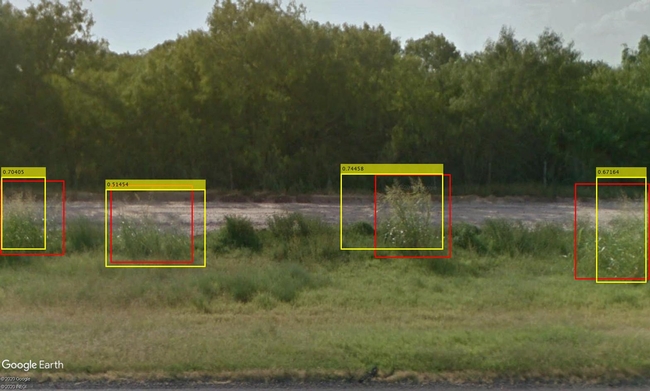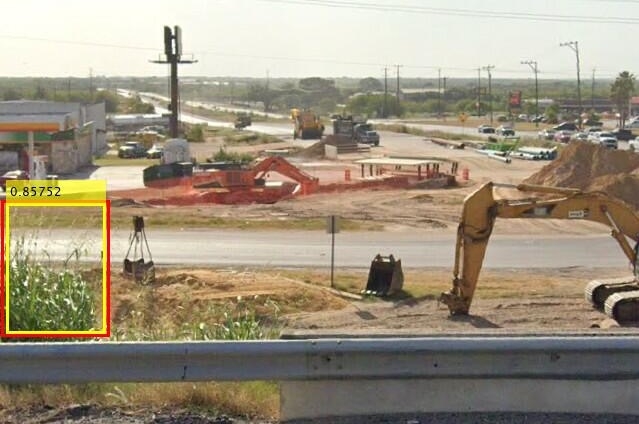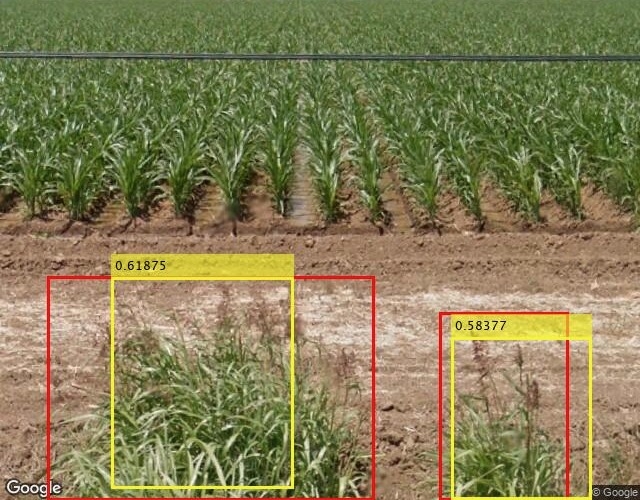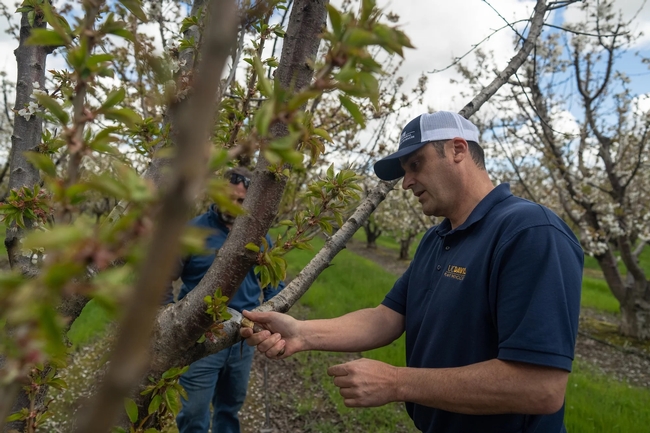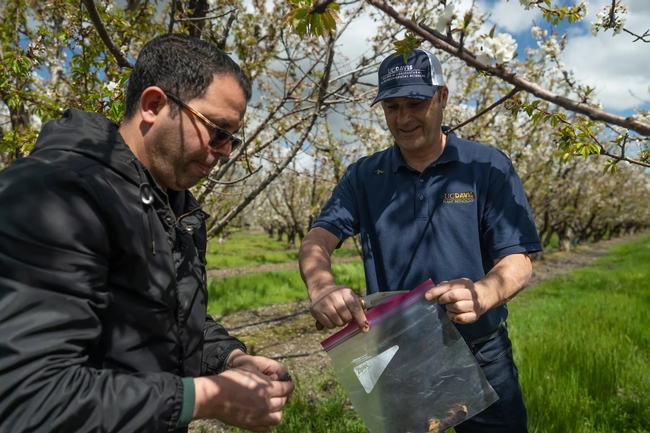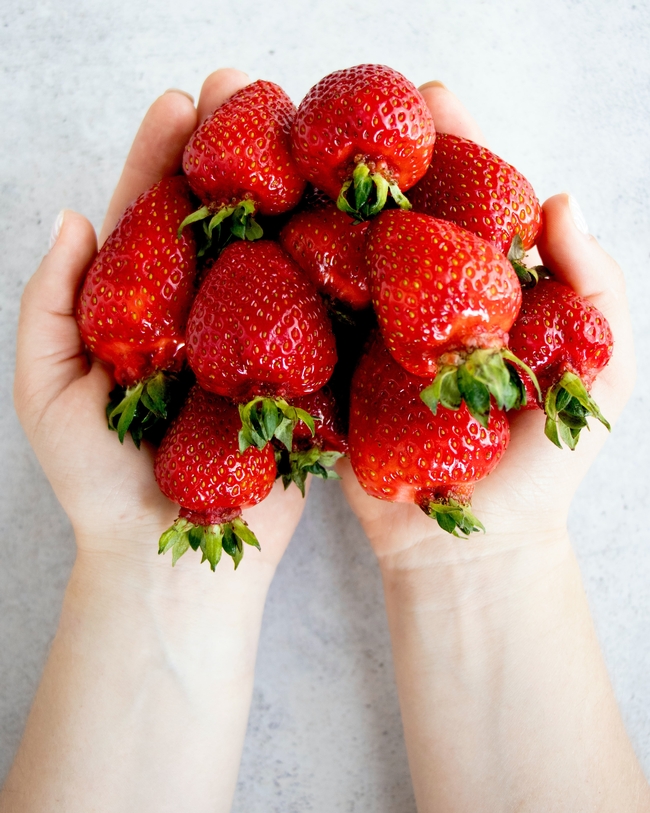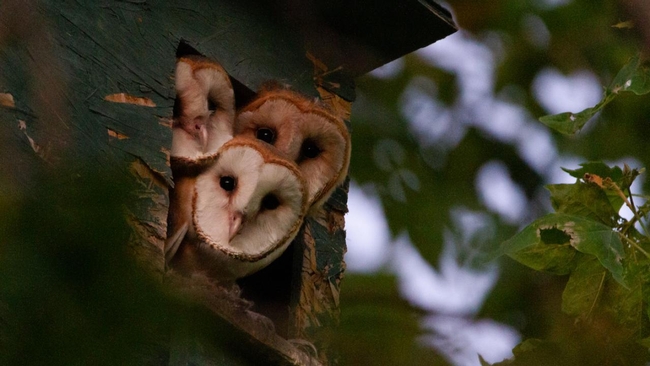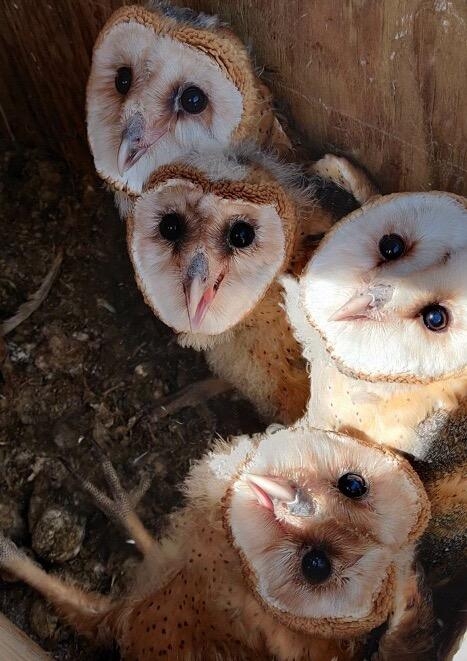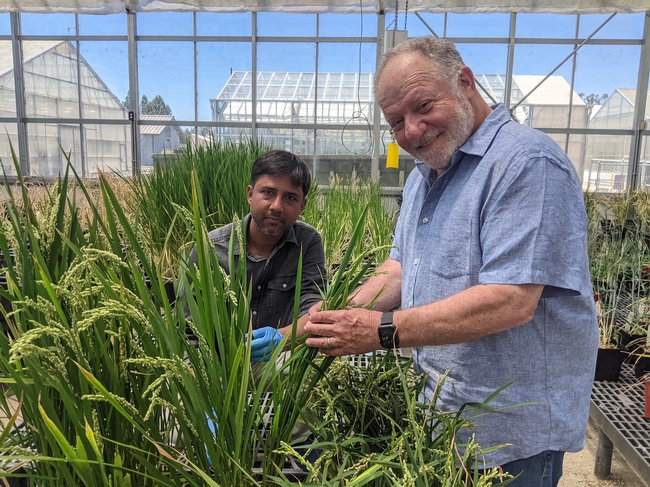Posts Tagged: Emily C. Dooley
Google Weed View? Professor trains computer to spot invasive weed
Algorithm for AI enables low-cost tracking of invasive plant
To manage johnsongrass, a noxious weed that crowds out cotton and sickens horses, farmers have tried herbicides, burning and hand-pulling. Now, researchers at University of California, Davis, have developed a more high-tech weapon against the invasive weed: artificial intelligence and machine learning.
Using photos from Google's Street View database, UC Davis researchers have tracked down over 2,000 cases of johnsongrass in the Western United States for a fraction of the cost and time that it would take to do drive-by or other in-person surveys. They call their tool Google Weed View.
The advancement could help land managers easily and quickly survey for other problem plants.
“Once the model is trained, you can just go and run it on millions of images from Google Street View,” said Mohsen Mesgaran, an assistant professor in the Department of Plant Sciences at UC Davis. “We have huge flexibility, and its capability can be scaled up very quickly.”
The technique can easily be extended to other plant species. All that is needed is to label the new item in Street View photos and train the algorithm to identify that object in the images.
By providing location information, Google Weed View also offers an opportunity to examine how climate affects the growth and spread of weeds and invasive plants at very large scales.
“I think it can be both useful for management and for people with interests in more basic questions in ecology,” Mesgaran said.
A colleague's query
Mesgaran began looking at using Google's photo database of roadways, streets and highways after Kassim Al-Khatib, a professor of Cooperative Extension in the same department, asked if he could survey Western states for johnsongrass.
Al-Khatib studies where johnsongrass grows, ways to manage it and how this perennial has evolved to be so prevalent and resilient. He's also working with scientists at the University of Georgia to decode the genome of johnsongrass, which is one of the top 10 most invasive weeds worldwide.
Johnsongrass can crowd out native plants, harbor pathogens and affect agriculture. It grows up to 7 feet tall with flowers that are green, violet, dark red or purplish brown depending on maturity, according to a UC Statewide Integrated Pest Management Program briefing page.
“Johnsongrass is a major weed not just in California but worldwide,” Al-Khatib said. “It's very difficult to control. It's a problem on vineyards. It's a problem for cultivated crops. It's a problem on orchards.”
Google Weed View allows for rapid, convenient scanning. It is continuously updated via everyday users with compatible cameras and images collected by Google. “Instead of a day of in-person driving, we can use AI to determine if johnsongrass is in a county or not,” Al-Khatib said.
Setting the parameters
To find the weeds, Mesgaran went to Google Street View, which hosts billions of panoramic photos. It didn't take long to find johnsongrass.
“The pictures are really good quality,” he said. “You can see plants and flowers.”
Street View's photos offer a 360-degree view, so in his request Mesgaran set parameters, based on street direction (bearing), to only see the side view. He also specified latitude and longitude, and other factors. To train the deep, or machine learning model, he chose Texas, where johnsongrass is prevalent.
A student sorted through over 20,000 images from that request to find pictures with johnsongrass and drew rectangular shapes around the weeds. They located 1,000 images.
The labeled photos were fed into a computer to train a deep learning algorithm capable of identifying johnsongrass in Google's images. The model was run again to capture potentially more images containing johnsongrass. These additional images were then labeled and used to further refine the model. With each iteration, the algorithm learned and became more accurate.
“This deep learning model was trained by these images,” Mesgaran said. “Once we had a semi-working model, we ran it against about 300,000 images.”
For Al-Khatib's request, researchers focused on 84,000 miles of main roads in California, Nevada, Oregon and Washington states. The team discovered 2,000 locations with johnsongrass.
Google Weed View cost less than $2,000 to purchase the images and teach the model. A traditional car survey to cover the same area would cost an estimated $40,000 in gas, hotel, food and other costs.
“In a matter of months, we came up with 2,000 records and I can do it for the whole U.S.,” Mesgaran said.
Next up? The entire United States.
This story was originally published on the UC Davis College of Agricultural and Environmental Sciences news site.
Winter atmospheric rivers gave pathogens, diseases path to infect crops
Outbreaks similar to El Niño-influenced issues of the 1990s
The wave of atmospheric rivers that swept across the state this winter has created the right conditions for plant pathogens that haven't been seen for decades in California. University of California, Davis, plant pathologist Florent “Flo” Trouillas is getting more calls from growers and farm advisors concerned about potential crop damage.
“Generally, whenever you have rain events, you're going to have problems,” said Trouillas, a Cooperative Extension specialist who is based at the Kearney Agricultural Research and Extension Center in Parlier. “In wet years we get really busy because most pathogens need and like water.”
Trouillas is like a disease detective. He splits his time between the field and the lab, working to diagnose pathogens, diseases and other ailments that strike fruit and nut crops such as almonds, cherries, olives and pistachios.
On a recent visit to an almond orchard near Fresno, Trouillas joined Mae Culumber, a nut crops farm advisor for UC Cooperative Extension Fresno County. A few weeks earlier, the two had walked the orchard, taking note of the base of some trees that had gumming — a thick, jelly-looking substance indicating a pathogen had taken hold.
“A lot of what Florent is doing is trying to assess patterns on a landscape,” Culumber said. “Sometimes things may look like they are one thing, but it could be another problem.”
When the two returned weeks later, the amber-colored gumming had moved into the canopy, looking like gumballs stuck to branches, some of which were already dead. “It's getting out of control from before,” Trouillas says. “This branch was killed. This is widespread.”
From the field to the lab
Lab testing confirmed what Trouillas believed was the culprit: Phytophthora syringae, a pathogen that can affect almond crops but is rarely seen in California. If it is found, generally the site of infection are wounds caused by pruning, but that is not the case here, where the infection began in the canopy at twigs, or small branches.
It is a threat to a key crop, which according to the California Department of Food and Agriculture, generates $5 billion annually. The last time Phytophthora syringae hit California was in the 1990s after a series of El Niño-influenced storms. Trouillas, who has a photographic memory, remembered reading about it in an old manual.
“It's rare for California and one that we see mostly following atmospheric rivers,” he says.
“The disease will only happen following these extremely wet winters.”
Phytophthora is soilborne, mostly found in tree roots, and doesn't generally spread up into branches. But the intense storms created the right conditions for the pathogen to “swim” up trunks as winds blew spores into the air and rain dropped them back down into the canopy, Trouillas said.
Some of the trees in this orchard will die; others can be saved by pruning infected branches and applying a recommended fungicide, he said.
Identification, diagnosis, education
Trouillas is one of more than 50 Cooperative Extension specialists at UC Davis and each is charged with identifying problems and developing solutions for those issues in support of agriculture, the ecosystem and communities throughout the state.
In his role, Trouillas focuses not only on pathology and research but also on educating growers, nursery staff, pest control advisers and others in agriculture about ways to manage potential threats and how to prevent crop damage.
“His role is very crucial,” said Mohammad Yaghmour, an orchard systems advisor for UC Cooperative Extension Kern County. “He's not only on this mission to educate growers but he's also a source of education for us.”
Trouillas typically conducts one or two site visits a week, usually after a farm advisor reaches out about a problem they can't solve on their own.
“This allows us to be at the forefront of disease detections in California,” he said.
He likens these visits to house calls a doctor would make, only to fields instead. And one of those calls recently took him to a cherry orchard in Lodi.
“These guys help me quite a bit,” said Andrew Vignolo, a pest control adviser with Wilbur-Ellis who asked for a consult. “I bug them a lot.”
The visit starts like any consult in a doctor's office, only the questions come fast as they walk around the Lodi orchard where branches are dying, there is gumming and the trees appear stressed. Some look to be sunburned from exposure. Old pruning wounds show cankers, indicating that past disease treatments didn't get rid of whatever was affecting the trees.
Trouillas asks about the cultivar of the trees because some varieties are more susceptible to pests or diseases. He focuses on stress because that opens the door to disease.
Do they prune in the dormant winter months or in summer when pathogens are more prevalent? Does the soil get tested? How old are the trees? What about nutrition?
“I'm trying to figure out how they got infected so bad,” Trouillas said, walking the orchard. “Bacterial canker is a very mysterious disease.”
He thinks it might be a bacterial canker disease and shaves some bark to take to the lab for testing. He wants to come back next winter to take some samples to see where the pathogen is overwintering.
“We'll know in a few weeks if we have a fighting chance,” Vignolo said.
Be it Lodi, Fresno or elsewhere in the state, Trouillas focuses on local conditions. But what is learned in one field can be passed on to others, providing early warnings or advice for those in similar situations. “All these efforts at collaboration, from the field, to the lab, going through research projects, there's only one goal here — to help the farmers of California.”
UC Davis awarded grant to advance strawberry breeding, genetic tools
The $6.2 million grant centers on protecting crops in the future
The federal government is awarding $6.2 million to University of California, Davis, to study how to use breeding and genetic information to protect strawberry crops from future diseases and pests.
The four-year grant from the National Institute of Food and Agriculture (NIFA) centers on addressing expanding and emerging threats to strawberries, a popular fruit packed with Vitamin C and key to the diets of many Americans.
Enhanced plant breeding, gene editing and other technologies will be key to ensuring strawberry crops are sustainable in the face of climate change and possible restrictions on chemical use, said Steve Knapp, director of the Strawberry Breeding Center and a distinguished professor in the Department of Plant Sciences.
“We need to have the technology so that we can deal with the challenges strawberries face around the world,” Knapp said. “Can we use genetic knowledge to change the DNA in a specific way to get the resistance we need?”
USDA funding
The grant award was one of 25 announced Oct. 5 by NIFA – an agency of the U.S. Department of Agriculture – as part of the Specialty Crop Research Initiative program, which addresses “key challenges of national, regional and multistate importance in sustaining all components of food and agriculture…,” the agency said.
The strawberry industry has lagged behind crops like tomato and wheat when it comes to genetic and technical innovation, Knapp said, and the grant signifies that “now they want the foot on the accelerator.”
A key priority is identifying whether changing DNA molecules can improve disease resistance and what technologies would be needed. Ensuring some genes are expressed while others are suppressed would be part of the analysis.
“We're trying to build in natural resistance to pathogens through the genes that already exist but could be modified with this knowledge,” Knapp said. “If we were able to edit a gene that improves disease resistance, people would want us to use that in breeding.”
The intent is to produce disease-resistant cultivars and identify better ways to diagnose, prevent and manage disease. The research project will also include an economic forecast evaluating the consequences of production changes and communicating with farmers about the laboratory advances, according to the grant proposal.
Gitta Coaker from plant pathology and Mitchell Feldmann, Marta Bjornson and Juan Debernardi from plant sciences are participating in the research, as are scientists from California Polytechnic State University, UC Agriculture and Natural Resources, UC Berkeley, University of Florida and USDA's Agricultural Research Service.
Fall is best time to clean nest boxes for barn owls
Research shows land managers should clean nest boxes in autumn to avoid disturbing the raptors
When it comes to American barn owls, forget spring cleaning.
The best time of year to clean out nest boxes to ready them for breeding pairs is the fall months of September through November, according to research out of the University of California, Davis, that analyzed nearly a century of banding and other records.
In a paper published in the Journal of Wildlife Management, researchers found that the median egg laying date for barn owls (Tyto furcata) in California is Feb. 20, so cleaning nest boxes in the fall is recommended.
“The risk is you could disrupt a nest that has already started,” said lead author Ryan Bourbour, a Ph.D. candidate in ecology in the Department of Animal Science at the time of the study. “We want to reduce disturbances to nesting pairs even in the weeks prior to egg laying.”
American barn owls offer a natural way for land managers and agricultural operations to control pests, because the raptors eat mice, gophers and rats. One breeding pair can consume up to 2,000 rodents annually, according to the UC Davis School of Veterinary Medicine.
But natural tree cavities and old barn structures are not as plentiful as they once were, so installing nest boxes can attract the barn owls. And land managers who spend money installing these “nest box networks” have long asked about the best time of year to do maintenance and cleaning. Planning cleaning and maintenance well before the start of the breeding season is “part of making that nest box worthwhile,” Bourbour said.
Pellets add up
After eggs hatch, nestlings spend their early days eating and living in the nest boxes until they are able to leave the nest, said Breanna Martinico, another paper author and an animal science Ph.D. candidate in ecology.
The nestling period of roughly 65 days is considered long.
“That's two months where owls are living and growing exclusively in that nest box,” said Martinico, who is also a UC Cooperative Extension human-wildlife interactions advisor in Napa, Lake and Solano counties.
As many as five or six nestlings are typically in a box, and they eat up to four or five rodents each day. Nestlings swallow their prey whole, and what isn't digested — fur and bones — is coughed up in round or oval-like pellets.
“They're in there for seven to eight weeks just regurgitating these pellets,” Bourbour said. “A lot of pellets pile up over the course of a breeding season and a lot of these boxes need to be cleaned out.”
From anecdotal to data
Discussions about how early the breeding season starts have mostly been anecdotal. To get a better picture, the paper's authors analyzed 96 years of banding records from the United States Geological Survey Bird Banding Lab and 39 years of intake records from California Raptor Center at UC Davis. Both databases helped them estimate the typical egg laying time of year in California, Martinico said.
Having this information can help land managers ensure maintenance is done and nest boxes are safe for the next breeding pair, helping barn owl populations while also benefiting agricultural operations.
“We can give them tools to manage barn owl nest box networks effectively and maximize pest control through owls,” Martinico said.
Additional co-authors include Emily Phillips, Jessica Schlarbaum and Joshua Hull in the Department of Animal Science, Michelle Hawkins in the Department of Medicine and Epidemiology at the UC Davis School of Veterinary Medicine and Sara Kross from Columbia University.
Funding came from the National Institute of Food and Agriculture's Western Sustainable Agriculture Research and Education program.
The journal article is entitled Banding records of nestling barn owls reveal optimal timing for nest box maintenance in California.
Growing cereal crops with less fertilizer
Discovery could reduce nitrogen pollution, save farmers billions
Researchers at the University of California, Davis, have found a way to reduce the amount of nitrogen fertilizers needed to grow cereal crops. The discovery could save farmers in the United States billions of dollars annually in fertilizer costs while also benefiting the environment.
The research comes out of the lab of Eduardo Blumwald, a distinguished professor of plant sciences, who has found a new pathway for cereals to capture the nitrogen they need to grow.
The discovery could also help the environment by reducing nitrogen pollution, which can lead to contaminated water resources, increased greenhouse gas emissions and human health issues. The study was published in the journal Plant Biotechnology.
Nitrogen is key to plant growth, and agricultural operations depend on chemical fertilizers to increase productivity. But much of what is applied is lost, leaching into soils and groundwater. Blumwald's research could create a sustainable alternative.
“Nitrogen fertilizers are very, very expensive,” Blumwald said. “Anything you can do to eliminate that cost is important. The problem is money on one side, but there are also the harmful effects of nitrogen on the environment.”
A new pathway to natural fertilizer
Blumwald's research centers on increasing the conversion of nitrogen gas in the air into ammonium by soil bacteria — a process known as nitrogen fixation.
Legumes such as peanuts and soybeans have root nodules that can use nitrogen-fixing bacteria to provide ammonium to the plants. Cereal plants like rice and wheat don't have that capability and must rely on taking in inorganic nitrogen, such as ammonia and nitrate, from fertilizers in the soil.
“If a plant can produce chemicals that make soil bacteria fix atmospheric nitrogen gas, we could modify the plants to produce more of these chemicals,” Blumwald said. “These chemicals will induce soil bacterial nitrogen fixation and the plants will use the ammonium formed, reducing the amount of fertilizer used.”
Blumwald's team used chemical screening and genomics to identify compounds in rice plants that enhanced the nitrogen-fixing activity of the bacteria.
Then they identified the pathways generating the chemicals and used gene editing technology to increase the production of compounds that stimulated the formation of biofilms. Those biofilms contain bacteria that enhanced nitrogen conversion. As a result, nitrogen-fixing activity of the bacteria increased, as did the amount of ammonium in the soil for the plants.
“Plants are incredible chemical factories,” he said. “What this could do is provide a sustainable alternative agricultural practice that reduces the use of excessive nitrogen fertilizers.”
The pathway could also be used by other plants. A patent application on the technique has been filed by the University of California and is pending.
Dawei Yan, Hiromi Tajima, Howard-Yana Shapiro, Reedmond Fong and Javier Ottaviani from UC Davis contributed to the research paper, as did Lauren Cline from Bayer Crop Science. Ottaviani is also a research associate at Mars Edge.
The research was funded by the Will W. Lester Endowment. Bayer Crop Science is supporting further research on the topic.
Editor's note: Blumwald is affiliated with UC Agriculture and Natural Resources through the Agricultural Experiment Station at UC Davis.

